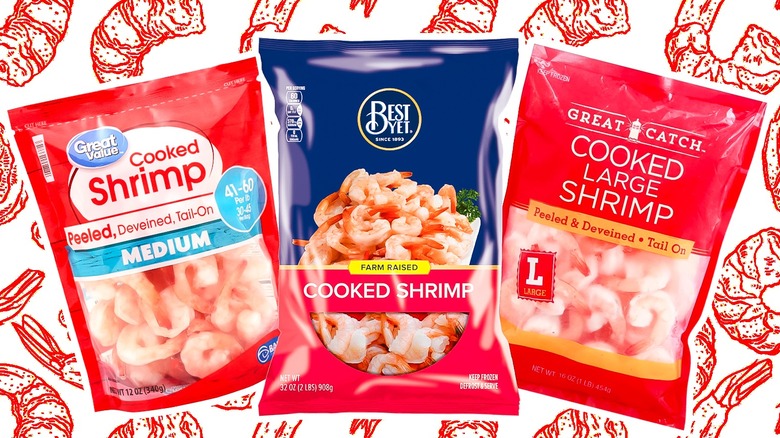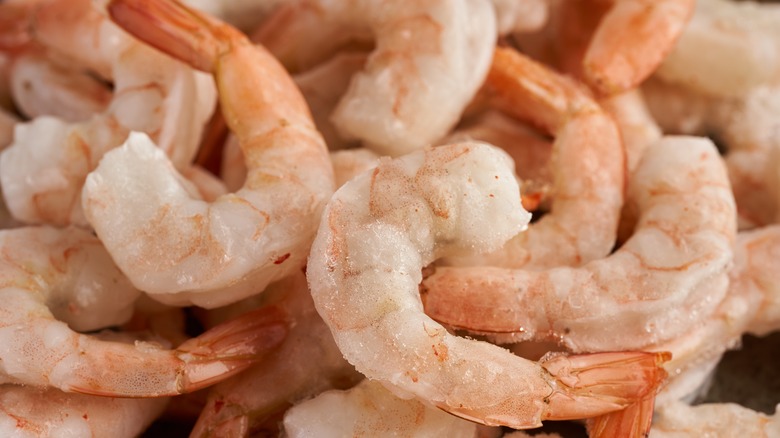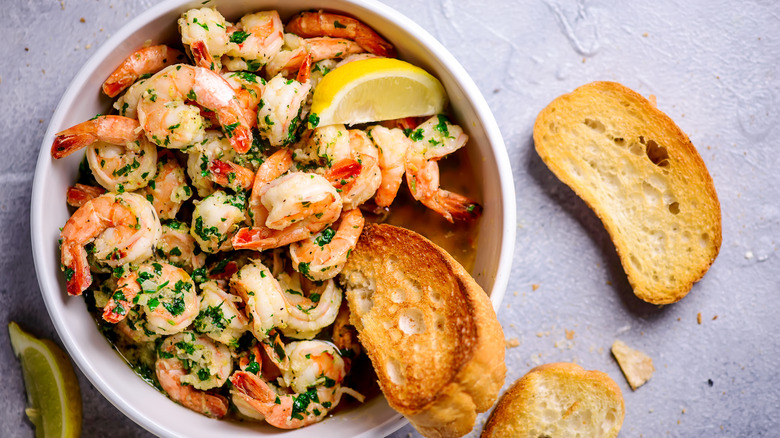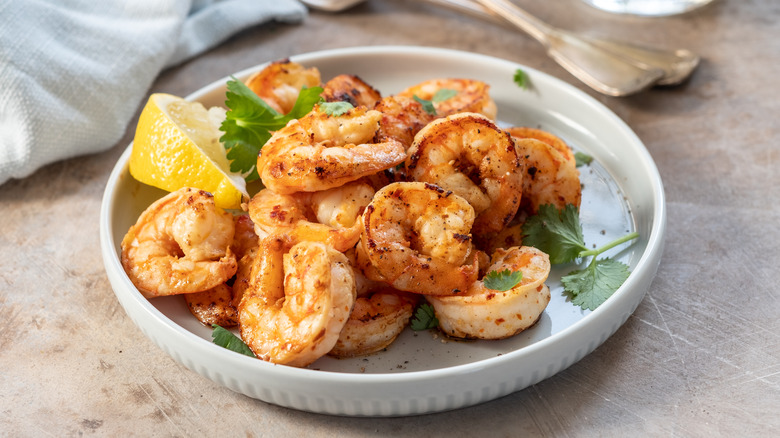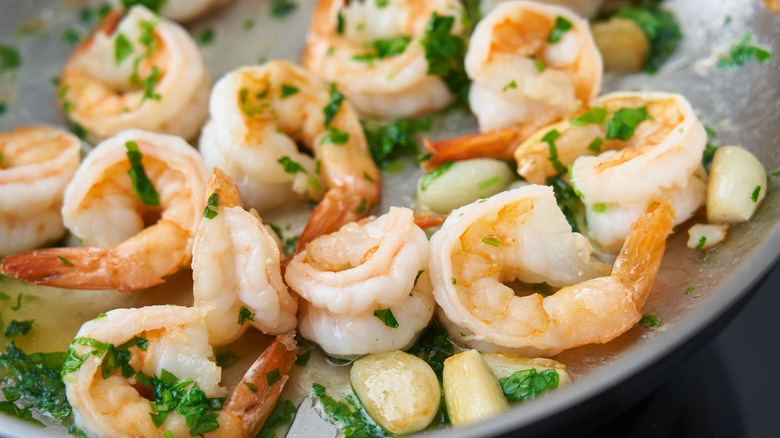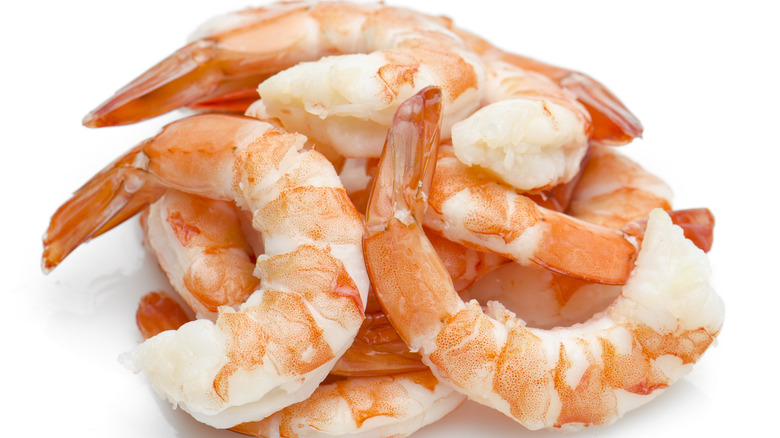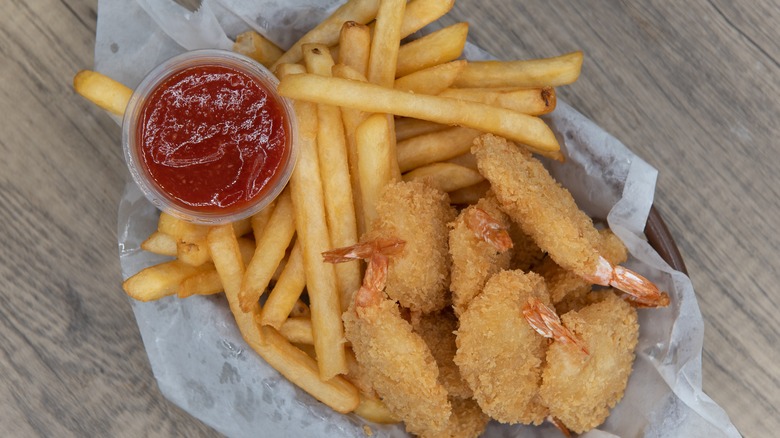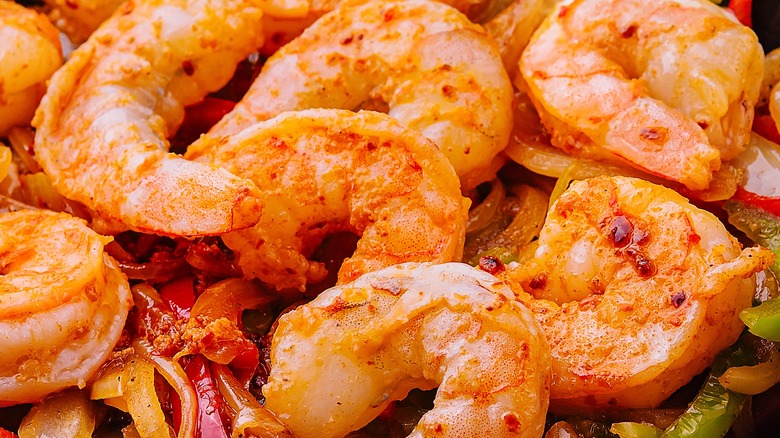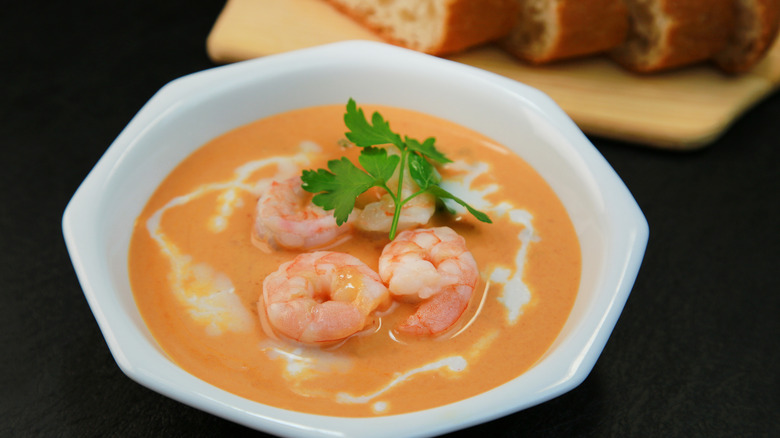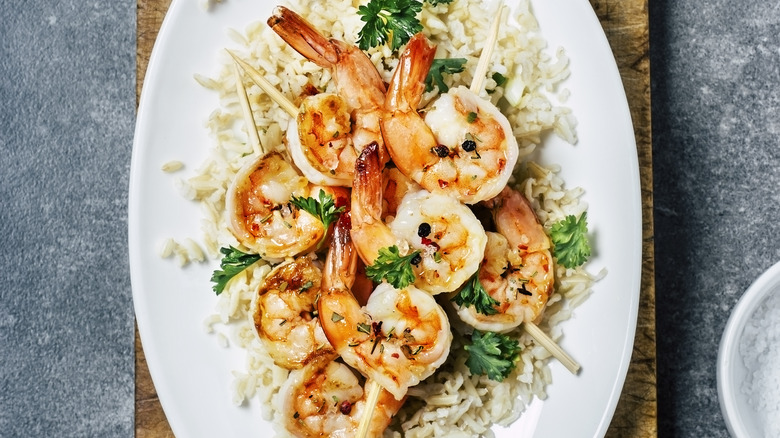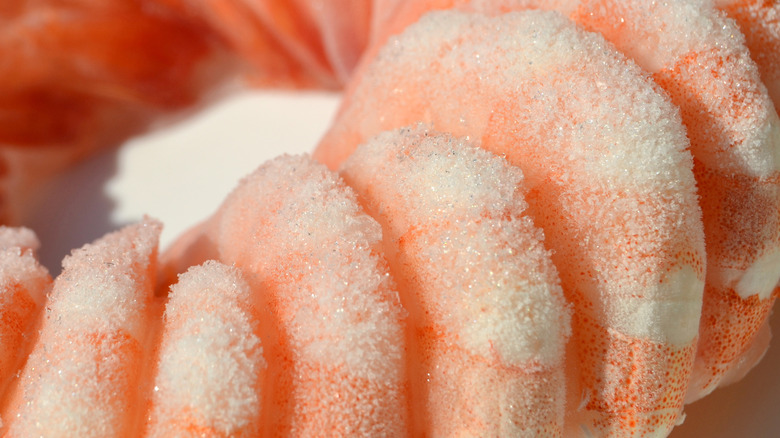11 Common Mistakes To Avoid When Using Frozen Cooked Shrimp
Shrimp are the undersung heroes of seafood. Their delicate flesh turns into plump, firm, tasty little morsels when cooked, and there are so many ways to have them. You can bread them and deep dry them, add them to curry, oven bake them, grill them on a barbecue, steam them, add them to pasta or a casserole, mince them up to make dumpling filling, toss them with some fried rice, eat them cold in a salad, and the list goes on. They take on seasonings and sauces really well and also taste great plain, without much added to them.
There's often the belief that buying fresh seafood is better than buying frozen, but with shrimp, this is a common misconception and the biggest mistake you make when buying shrimp at the grocery store. Unless you're buying fresh shrimp directly from a fisherman's catch, the unfrozen shrimp you find at your store was likely frozen and defrosted. That's why buying frozen shrimp is the better option. Plus, you can get frozen cooked shrimp, which makes everything about preparing them so much easier. Shrimp can be really easy to cook but also easy to mess up. With frozen cooked shrimp, if you don't avoid certain mistakes, you can end up with tough, overcooked, or watery shrimp. As a recipe developer, I turn to frozen cooked shrimp often and have learned which mistakes to avoid along the way. Once you know what to do and what not to do, it can be one of the most convenient foods to cook.
1. Thawing your shrimp incorrectly
As with any frozen food product, it's important to thaw shrimp safely. There are different ways to thaw foods, and shrimp is no different. However, like many other foods, the absolute best method to thaw shrimp without ruining them is to do so slowly in the fridge overnight. Don't let your shrimp thaw and sit in its own juices. This should be done in a colander with a plate or bowl underneath so that any water that melts and releases from the shrimp can drain away.
If you didn't plan ahead and thaw your shrimp overnight, don't worry. It's possible to do a quick defrost with your shrimp. Keep your shrimp in a sealed bag and submerge it in some cold water for a couple of minutes. They should thaw pretty quickly, but whatever you do, don't use warm or hot water to speed things up. Additionally, never use the microwave to thaw your shrimp.
When your shrimp has thawed, rinsing them before cooking is advised. Even if you've defrosted your shrimp properly, there might still be the melted water or some remaining ice crystals on each one. This isn't harmful, but they can add unwanted water and fishy flavor into your dish unnecessarily. Plus, giving your shrimp a quick rinse will help loosen any shrimp or pieces that have become stuck together.
2. Not patting them dry before using
After giving your shrimp a rinse, it's imperative to pat them dry. In fact, even if you haven't rinsed them, they'll still have some water on them from the thawing and will need to be dried off. This is because excess water won't do your shrimp any favors while it's cooking. You'll end up boiling your shrimp instead of managing to get it to brown and develop a good flavor before it overcooks. Having water on your shrimp will make it take longer to brown. Instead of being able to achieve the Maillard reaction, by the time you've cooked it for long enough to evaporate all the water, your shrimp will likely overcook and become dry instead of supple and succulent.
Another reason to pat your shrimp dry is because any seasonings you add to it won't stick. Instead, they'll likely leach away into the water and end up in the pan, rather than giving your shrimp meat the flavor you desire. This applies to any breading or batter you might want to coat your shrimp with, as any coating won't adhere to the shrimp enough. So, take this step, because it will make your shrimp cook and taste better. You can use a paper towel or kitchen towel to pat the shrimp down. Alternatively, leaving the shrimp to drain in a colander overnight in the fridge will have the same effect.
3. Forgoing a marinade
When you use frozen cooked shrimp, it's easy to forget that they still benefit from some warming up and even a little bit of cooking to make them delicious and soak up the flavors of your dish. That's why you shouldn't skip out on making a marinade for your shrimp. Just because they're precooked, it doesn't mean they won't absorb a marinade. It can be as simple as olive oil, garlic, and lemon juice, and your shrimp will taste incredible. In truth, there are numerous ways to add flavor to your shrimp. As long as you add your marinade after thawing them and patting them dry, they'll be ready to receive whatever delicious seasonings and condiments you want to add.
Starting with an oil base is a good idea since it will help any spices, herbs, or alliums to stick to the shrimp better. Otherwise, you can even make a liquid base of soy sauce or even honey, depending on the flavor profile you're after. You shouldn't shy away from fresh garlic, shallots, herbs, or some lemon or lime zest, as they'll add a lot of brightness and make your shrimp taste like you've cooked them from raw. Place all your ingredients in a sealable bag with your shrimp and leave it in your refrigerator until it's time to cook. You don't need to leave them for hours and hours if you don't have the time; even just one hour is enough.
4. Overcooking frozen cooked shrimp
It's pretty easy to overcook raw shrimp as they cook incredibly fast. Sometimes, it can be as little as two to three minutes of cooking per side to get them fully cooked. This is of course depending on the size, as larger shrimp can take longer, and smaller shrimp will cook much quicker. So, when it comes to using cooked shrimp, you have to be extra careful not to overcook them. This is where there can be some confusion because even though you're using cooked shrimp, it makes sense that you'll have to cook them a little bit more if you want the flavors of your dish to infuse and come together in a cohesive dish. That's why if you're making a shrimp curry for example, you don't want to just add them in after cooking as they'll probably taste disjointed from your curry sauce.
The tricky part is that if you cook them for even a little bit too long, they'll overcook and become rubbery, and while not inedible, can be unpleasant. In my experience, you just need to warm them through and brown them. Whether you're cooking them on the stove, the grill, or in the oven, cook them on medium heat for just about 2 to 3 minutes, (or up to 6 minutes in the oven).
5. Removing the tails carelessly if they still have them
Getting shrimp with no shells is definitely a convenient choice for most dishes. Especially when making dishes like shrimp pasta or shrimp curry, it's not a pleasant experience having to take any shells off each individual shrimp while eating. This is why people might opt for frozen cooked shrimp because they're cleaned and deshelled. But there are some frozen cooked shrimp packets that have tails. They're not as time consuming as trying to remove the entire shell, but they can be annoying as you still need to bite or cut them off while eating. If you do get frozen cooked shrimp with tails intact but you don't want to keep them on, then it's important to be careful when removing them.
Shrimp meat is incredibly delicate, and any strong tugging or even just rough handling can damage it or cause it to lose its shape. I like to use a sharp paring knife to cut off the tails and avoid any knives that don't seamlessly cut through the meat. I even recommend using some sharp scissors that simply snip them right off without having to agitate the shrimp by cutting back and forth.
6. Using shrimp with no tails if you're breading them
Many people prefer to buy frozen cooked shrimp with zero shells on, including tails, and I can't blame them for that. It makes it really easy to eat in most dishes. However, this isn't the rule for all dishes. In fact, it's a different story if you plan to use your shrimp to bread them or dip them in batter, to deep fry them into crispy fried shrimp. This is when you should look for the shrimp with tails intact.
I have found them much easier to handle when deep frying, since you can hold the shrimp by their tails, whether you're dipping them into an egg mixture, breadcrumbs, batter, flour, or hot oil. Keeping you from ruining your actual shrimp meat or removing the breading by holding them by the flesh, the tails make the perfect tip to grab hold of with two fingers and move the shrimp around.
7. Underseasoning or overseasoning frozen cooked shrimp
If you've ever ordered a classic shrimp cocktail before, you know that it's possible to serve shrimp with zero seasoning if you've got a spicy or tasty sauce to dunk them in. In all other cases, shrimp can be made infinitely better with the right seasonings. This applies to frozen cooked shrimp, which can easily absorb seasonings like it would a marinade. To bring the best out of your shrimp, a simple seasoning of salt and pepper is essential, but you can also add extra spices like paprika, cayenne pepper, cumin, celery salt, garlic powder, and much more, to make them extra zingy and tasty. Add your seasonings before you cook them so that they have some time to seep into the flesh.
That being said, it's also good to practice some restraint. Shrimp meat is so delicate and tasty in its own right that you also don't want to overwhelm it by drowning it in seasonings. Also, if you're using smaller shrimp, it can be easy to oversalt or overseason them. In this case, less is more, and you can always add more at the end after tasting if you feel they still need extra seasoning.
8. Throwing away any tails
If you do happen to buy frozen shrimp that still have their tails on, then don't throw them away. What you may not know is that shrimp shells are so much more than a waste product. They are packed full of flavor and can make a really tasty broth for all sorts of dishes, like soups and sauces. You can even make a creamy seafood bisque by making a stock with these tails.
Save them aside to be simmered in some water along with some aromatics, spices, and more. I like to roast them until they're brown and crisp to deepen the flavor of your broth or even blend them up into a powder after roasting. Mixing this powder with some salt makes a delicious shrimp seasoning that I use on top of grilled shrimp, shrimp bisque, and grilled fish for extra fishy goodness. Shrimp tails may not seem like much compared to whole shells, but they are still useful and full of delicious flavor that tossing them in the trash is a missed opportunity for making something delicious.
9. Thinking you can't cook them in the air fryer
Air fryers are a recent invention that has offered people even more convenience with cooking. They don't need to be preheated like standard ovens, and they cook things much faster, too. You wouldn't be blamed for thinking that it would be too easy for frozen cooked shrimp to overcook if you throw them in an air fryer, but that doesn't mean you should avoid them altogether. In my experience, air fryers can be incredibly useful and make delicious shrimp if you use it the right way. The trick to doing so with frozen cooked shrimp is to cook it from frozen. There's no need to defrost your shrimp because the air fryer heats it up so quickly that it will likely overcook if you thaw them out first.
It's still worth giving your frozen shrimp a quick rinse under some cold water to remove any extra ice crystals as mentioned above. Simply pat them dry of any excess water and toss them with your seasonings. Then, place them in the air fryer at 400 degrees F for 5 minutes.
10. Leaving them in your freezer for way too long
Many frozen products can last a really long time in your freezer, and this is why we tend to forget things in there for ages. If you've ever decided to clean out your freezer, it's likely that you've found products in there for over a year. Yes, we love frozen foods like frozen cooked shrimp because of the convenience that we don't have to worry about them spoiling. However, if you want to enjoy these foods with the quality they're meant to have, then it's best to eat them within a good amount of time. With frozen shrimp, it's always important to go by the expiration date.
If, for some reason, the expiration date has faded, a good rule of thumb is to only keep frozen shrimp between ten to twelve months in your freezer. However, while they may be safe to eat, they may not still be as tasty or have the plump texture you desire if you keep them for that long, so try not to forget about them and use them within a couple of months, and always before the expiration date to get them at peak quality.
11. If barbecuing, forgetting to skewer frozen cooked shrimp
As we reach peak summertime, the hot weather makes us more and more likely to get the grill on for some outdoor gatherings and meals. There's no reason to leave shrimp out of all the fun because they make for a great food to pop on the grill. They'll cook really quickly and hopefully develop a beautiful browning or even char if you grill them right. One mistake people tend to make is to forgo skewering them. Sure, it's not an absolute requirement, but skewering them will make your life so much easier. Most shrimp are already so small compared to other foods that it can get tedious to place them all individually on the grill and turn them over one by one. If they're small in size, you risk damaging or overcooking them because you don't get to flipping or removing them in time.
Skewering your shrimp makes the whole process easier and more stress-free. It might be a little laborious to thread them on your skewers, but it will be worth it when you're grilling them and only need to pick up a skewer at a time instead of each shrimp.
